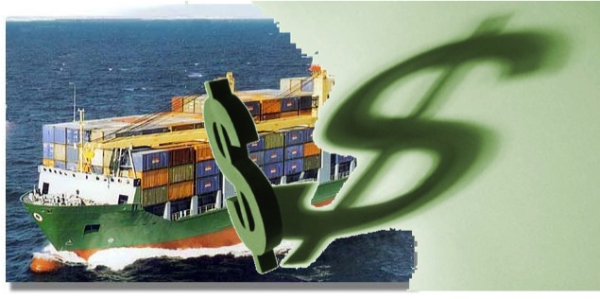Exporters Still Suffering High International Shipping Costs
Importers can thank goodness that their freight rates and international shipping costs are generally on par with pre-COVID levels and behaviors. To say the astronomically high freight rates and auxiliary costs through and well after the pandemic were unsustainable would be an understatement of the highest order. But while things are back to a level of normalcy for importers, exporters are still suffering much higher freight rates and costs than what would be considered normal.
Greg Miller reported on this just yesterday (September 18th) in a FreightWaves article:
Both spot and contract rates for U.S. exports are still up double digits from pre-COVID levels.
And rates are not the biggest cost issue exporters face, according to Peter Friedmann, executive director of the Agriculture Transportation Coalition.
Blank Sailings & Lack of Carrier Transparency

The biggest issue, according to Friedmann, has to do with all the blanked (cancelled) sailings ocean freight carriers have been doing and the lack of communication from the shipping lines about them. Regular readers of Universal Cargo’s blog know that blank sailings and carriers’ lack of transparency are things I bring up often.
Carriers have notoriously lacked transparency since long before I started writing about international shipping over a decade ago. And while blank sailings have always been a thing, I don’t recall ever seeing such a coordinated amount pre-pandemic. The blank sailings we’ve seen since have certainly been impactful.
Blank sailings preceded the first big spike in freight rates during the pandemic. Early on in 2020, it was presumed COVID would result in a drop in shipping demand with predictions of ocean freight carriers losing billions. Because ocean shipping was dominated by three major carrier alliances, those alliances were able to control capacity (demand) in the international shipping industry by blanking hundreds of sailings. They blanked so many sailings, despite an initial dip in shipping demand, carriers managed to drop supply well below that demand and make freight rates actually increase. Then demand for goods skyrocketed with a combination of lockdowns and government stimulus checks to everyone sending freight rates out of control. All those blanked sailings also messed up the distribution of shipping containers around the world, adding to congestion at ports and supply chain issues around the world, which in turn, added more upward pressure on freight rates.
When demand, which stayed near-record to record levels through 2020 and 2021, finally really started falling in 2022, carriers cranked blank sailings back up. The resulting supply chain issues, along with carriers’ lack of communication and transparency, are being particularly felt by U.S. exporters, as Friedmann told FreightWaves, and Miller reported:
[Friedmann] told FreightWaves that sailing schedules are now more irregular than before the pandemic, while ocean carrier communications to exporters are as bad as ever.Consequently, exporters are paying more in detention and demurrage and spending more on storage and trucking due to insufficient communications on erratic sailing schedules than they did prior to 2020.
“Higher rates have not been the primary issue because the rate issue is being overwhelmed by the additional costs imposed on exporters by the carriers’ inability or unwillingness to provide timely and accurate data on things like ERD [earliest return date], when the ship is coming in, and which terminal exporters should send the cargo to,” said Friedmann.
Friedmann’s choice to include the word “unwillingness” when talking about carriers not providing timely and accurate data is an interesting one. He may be implying intent from the carriers to increase the likelihood that shippers are having to pay more in detention and demurrage fees and other shipping related costs. The costly result for exporters could turn costly for carriers.
There’s a great deal of recent law changes to U.S. shipping code. Much of it is focused on scrutinizing carriers and detention and demurrage fees while making it easier for shippers to bring complaints against them and the Federal Maritime Commission (FMC) more powerful in judging and punishing carriers for practices that may be unfair.
Formal shipper complaints to the FMC against ocean freight carriers have ratcheted up. There have already been some rulings against carriers. Watching how the legal trends continue will be interesting.
Friedmann’s Argument Against Carriers’ Current Practice
Miller’s article gives details on specifics of freight rates for exporters as well as getting into how volume trends are currently better than import trends when it comes to volume growth versus loss. I’ll let you read that on the FreightWaves website, which I recommend, but I will share the complaint argument Friedmann makes on behalf of exporters that Miller reported:
Friedmann explained how carrier service strategy on the import side, combined with a lack of timely data, has translated into higher costs for exporters compared to the pre-pandemic era, above and beyond the rate issue.
“What determines the carriers’ placement of ships and services is the inbound cargo,” he said. “Export volumes and revenues are not their primary concerns when making that determination. And as import volumes have dropped, carriers have adjusted — and they’re still adjusting. The erratic schedules remain an issue and the question is how long it will last.
“The decision to blank [cancel] a sailing is not made three days before the ship is supposed to call at the terminal. Why aren’t carriers providing that information immediately upon making a decision?” he asked.
“When you go to the airport, your phone is blowing up with text messages saying the flight is delayed three minutes or the gate of departure is now E31, not E26. These are flights that are only a few hours long. Exporters ask: Why can’t ocean carriers tell them the date, time and terminal of arrival for a two-week voyage?
“I can’t tell you how many hours our agriculture exporters spend on the phone trying to find out which terminal they should send their exports to. The ocean carrier people will tell them: ‘We don’t know for sure. You’d better call the terminal.’
“I’m not saying people like paying higher freight rates, but you can kind of budget for freight rates. What’s impossible to budget for is when a carrier blanks a sailing or skips a port and doesn’t tell you soon enough — or a terminal is closed — and you’ve got storage costs and production costs and all sorts of additional trucking costs, and detention and demurrage charges that dwarf the freight rates. That’s the biggest challenge right now.”
Friedmann makes a good argument.
The import cargo to the U.S. from Asia that Friedmann brings up is more lucrative for carriers than U.S. exports going the other way. It makes sense that the imports would factor more heavily into carriers’ business and ship sailing decisions. However, it’s hard to understand why carriers are unable or unwilling to communicate better about ship departures, arrivals, and related information.
Perhaps carriers have an argument as to why they are unable to share this information in a more timely manner. They should probably start explaining quickly. Congress and the FMC appear to be addressing exporters’ complaints with the Ocean Shipping Reform Act of 2022 and the rulemaking the FMC has gotten from it. We’re only beginning to see the implications and results all this will have on the international shipping industry. But lawmakers appear to be writing some of the rules and regulations to protect shippers and target carriers.
Carriers likely should feel leery. In fact, there’s reason for us all to feel a little that way. Increased government involvement in an industry very often results, even if completely opposite of the intention, in the industry and its services becoming more expensive for the consumers. In the international shipping industry, that’s shippers.




